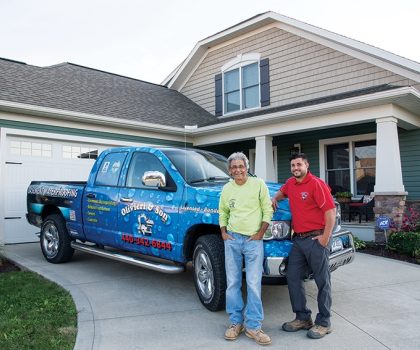Waterproofing at its best

By Randal Vanderhaven
Many old homes have destructive water and cracking on their basement walls.
Unfortunately, as Connie Lahr discovered, so do some new homes.
Connie, a schoolteacher, bought her two-year-old Medina home in 2013. Within a year she noticed water in her basement.
“I saw a line of water on the wall,” she recalls. “I had recently had a patio installed, and people were telling me that was the cause. I had the landscaper here and the home builder and nobody could tell me what was causing the problem.”
Finally, she called Olivieri and Son to have a look. Rocco Olivieri—the father in the team—knew right away what the problem was.
“Rocco explained that the foundation wasn’t properly backfilled,” Connie says. “The basement walls were surrounded by clay. When it got saturated with water, it put pressure on the foundation.”
Rocco says it isn’t uncommon to have water in new homes.
“Sometimes builders cut corners to save time and money and the homeowner gets stuck with a big problem,” he cautions.
Just before Rocco and his son, Mark, arrived to fix the problem, a heavy rainfall left Connie’s basement floor under two inches of water.
“We were trying to shop vac the water out, but as fast as we sucked it up more would come in,” she says.
Within a week, the problem was solved.
Many companies, Rocco emphasizes, waterproof from inside the basement, rechanneling intruding water back outside.
“That isn’t the best way to do it,” he insists. “The water is still penetrating your foundation and it can still do damage. That’s why we fix the problem from the outside to stop the water from entering in the first place.”
Rocco and Mark, who have been correcting foundation problems since 1981, begin the process by excavating the leaky walls all the way to the footer. They then pressure wash the foundation to clean the debris and highlight any cracks where moisture may be entering. Those cracks are patched and sealed with Waterplug Sealant. For added protection, they coat the end wall from the footer to grade with Thoroseal Sealant. Applying a tar rubber emulsion from footer to grade and wrapping with insulation is the final step in preventing moisture from penetrating the wall.
“For proper water drainage, we install four-inch heavy-duty perforated PVC along the footer,” Rocco explains. “We will also provide a clean-out on each wall that we excavate. The excavation is backfilled with No. 57 premium wash gravel to direct water to the drain tile.”
“Rocco and Mark were fantastic,” Connie reports.

“It was more than 90 degrees and they worked 12 hour days. They cleaned everything up before they went home. When the work was all finished, they put everything back the way it was, including the patio and the landscaping that they had to take out. They even watered my trees. Of all the people I have ever had working in my house they were the best to work with. I didn’t have to call them back to redo something. If they were going to be a little late they called to let me know.”
Some homeowners, Mark suggests, like the idea of waterproofing from the inside to avoid messy excavation work outside their home.
“It isn’t worth it,” he insists. “Foundation work is expensive. That’s why it makes sense to get it done right the first time. Our work is backed with a lifetime warranty.”
You can see for yourself how Olivieri and Son can stop water from invading your home’s foundation by visiting their website, at BasementAndWaterproofing.com. You can schedule a no-cost, no-obligation inspection by calling 440-342-6844.
